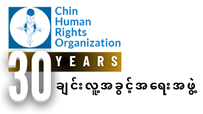Regarding Chin Refugees in India
HUMAN RIGHTS WATCH: INDIA MUST PROTECT CHIN REFUGEES
For immediate release
August 17, 2000
For more information contact:
Sidney Jones (NY) +1 212 216 1228 (w); +1 718 788 2899 (h)
Gary Risser (DC) +1 202 612 4342 (w); +1 301 949 1966 (h)
(New York, August 17, 2000)
Human Rights Watch today called on India to halt expulsions of ethnic Chin refugees to Burma where many could face persecution from the Burmese military. The Chin are an ethnic and religious minority in north-western Burma.
According to local sources, police in the Northeastern Indian state of Mizoram are preparing to deport another group of Chin this Friday. Last week authorities turned over more than one hundred Chin to the Burmese army along the border and have detained more than 1,000 others pending deportation. The Indian government claims the Chin are illegal immigrants.
“Any wholesale deportation to Burma without safeguards for protecting genuine refugees is unacceptable,” said Sidney Jones, Asia director of Human Rights Watch. “The general level of repression in Burma should be enough to justify those safeguards. But when the deportees belong to an ethnic minority, and the Burmese army is conducting counterinsurgency operations near their homes, protection becomes absolutely vital.”
The Indian government should give the office of the U.N. High Commissioner for Refugees immediate access to the detainees, she said, so that anyone with a valid fear of persecution could make a formal claim for refugee status.
At the moment, not only is there no presence of the U.N. High Commissioner for Refugees, but there is even concern that local officials may be ignoring the applicable law, which requires that any potential deportee have a judicial hearing.
Mizoram State borders on Burma’s Chin State, where the Chin National Front (CNF) has been fighting the Burmese government since 1988. Anyone the government suspects of having links to the rebels can face arbitrary arrest, detention, and, at times, torture. Villagers are subject to forced labor, forced portering, and religious persecution, as many of the Chin are Christians.
Though some ethnic minority Chin have been in India since the 1960s, most of the Chin refugees now in India fled there to escape abuses after 1988, when the Burmese government violently cracked down on the pro-democracy movement. An estimated 40,000 to 50,000 Chin now live in Mizoram alone. Since the Chin have no access to relief assistance, they are forced to survive by seeking work, particularly around Mizoram’s capital, Aizawl. Work as migrant laborers exposes Chin refugees to arrest and expulsion for illegal entry.
The Indian government has not signed the 1951 U.N. Convention relating to the Status of Refugees or its 1967 Protocol, nor does it have any domestic refugee law. The Foreigners Act, under which the Chin are being expelled, makes no distinction between illegal immigrants and refugees. The Indian government is, however, bound by the international principle of non-refoulement which prohibits the forcible return of refugees to situations in which they would be subject to persecution and where their lives and freedom could be threatened.
